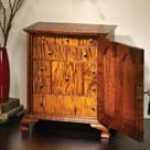We may receive a commission when you use our affiliate links. However, this does not impact our recommendations.

Which mills and router bits are best for cutting wood parts on a CNC? A handful of upcut, downcut, and compression bits are the best choices for digital woodworkers.
In this series on mills and bits for digital woodworkers, I introduced the basics of end mill and router bit design. If you missed it, here’s the introduction and parts one, two and three. With the basics completed, it’s time to focus on which mills work best for specific purposes. One of the best uses for a CNC is for cutting parts so, let’s see what mills and bits work best for that.
Choosing a CNC mill is a lot like the choice you’d make when selecting a table saw blade for a special use (ripping, crosscut or a standard combination blade). There are various types of end mills for use in cutting out wood parts. Two common mills are the upcut, for ejecting chips upwards where the bottom of the cut is smooth and the downcut, where waste is pushed down and top of the cut is smooth with no tear out. Then, there are compression cutters where both the top and bottom of the cut are smooth — which are great for cutting laminated materials with thin veneers like plywood. All of these mills are referred to as flat mills because they are flat on the bottom.
Spiral mills and router bits are the best choices for cutting wood parts
Earlier in this series, I explained that most general purpose end mills that work well for cutting wood have two flutes. Though, more flutes mean a smoother cut sounds good in practice, when cutting wood with a CNC added flutes don’t eject the waste fast enough and the mill overheats. So, stick with two flutes.
Diameters for two flute spiral bits range from micro size to as big a shaft as your CNC router or spindle can handle – usually, that’s 1/2”. The size of the mill also determines how fast you can cut the material (feed rates). Tiny end mills are very delicate and break easily – they require very shallow cuts and slow feed rates. Larger mills can remove a lot more material than smaller mills.
For the purposes of using a CNC to cut parts out of wood, you’ll want to use larger mills wherever possible. You’ll commonly find two flute wood cutting mills in diameters of .250”, .375” and .500”.
You also have choices to make regarding mill length. Because woodworkers frequently make hardwood parts of 4/4, 6/4, 8/4 and even greater than 12/4, we need longer bits so it’s best to shop for bits with appropriate cutting length (CL). Usually, that means .250” bits with cutting lengths up to 1.125”, .375” bits up to 1.25” and .500 bits from 2” to 2.500”. When it comes to end mill and bit materials, carbide or carbide coated offer longevity and heat resistance so that makes them your first choice.
Up, down or compression?
These three options refer to the cutting direction of the flutes on a mill. Whether it’s for use in a CNC or router, you’ll find a use for all three kinds of bits in your shop. An upcut mill pulls the waste out as the mill rotates. Downcut mills push the waste back into the mortise being cut. Compression mills do both. The top .250” or so of the mill pulls the waste out and the rest of the mill pushes down. The practical benefit of a compression mill is the clean edges it leaves on the surface as it’s cutting. If you cut deeper then the upcut flutes say, .260” the down cutting flutes will push down the top fibers leaving a clean top surface with no tear out. As you cut all the way through, the up cutting flutes pull the back side fibers into the mortise, leaving a clean bottom surface.
All three options have their place in a digital woodworker’s tool set. Here’s how I use them…
Upcut
I use upcut mills for hogging off as much material as I can as quickly as I can – and for cutting MDF and general use. I also use upcut mills for roughing large areas when doing 3D sculptural work.
Downcut
I use downcutting mills almost exclusively when cutting hardwood furniture parts. It’s my go-to choice. A downcut gives me a clean top surface and by pushing the wood down, it helps hold the part steady. Because downcutting bits are packing in waste into the mortise area, to keep the bit from overheating, you usually need to make shallower cuts at higher feed rates.
Compression
I almost always use compression bits for cutting plywood and other laminated material. And, if the cut is going to be over .250” on the first pass these also works well for cutting solid woods. Like the downcut bits, they typically need to be run faster then upcut bits.
Recommended sizes for cutting parts
I typically use .250” and .375” compression mills for cutting plywood. The larger mill size is preferred. But, if you’re cutting a lot of parts with little room in between them, the smaller size is handy. Perfect if you’ve filled up a sheet of plywood with parts.
For cutting hardwood furniture parts, I often use a .375” downcutting mill. If the part is thicker, like a 1.75 to 2” chair leg, for example, I use a .500” downcutting mill. They’re longer and more stable when cutting.
For general purpose needs, some soft wood cutting and fast material removal in preparation for 3D carving, I use .250”, .375” and .500” up cutting mills.
In the next segment on CNC Tooling basics, I’ll share what I’ve learned about the ball mills that I use for 3D carving.
To see the entire series on CNC Tooling Basics, click here.
Here are some supplies and tools we find essential in our everyday work around the shop. We may receive a commission from sales referred by our links; however, we have carefully selected these products for their usefulness and quality.









